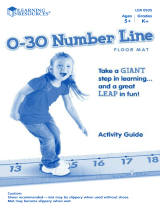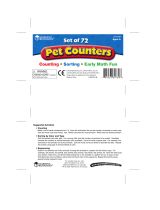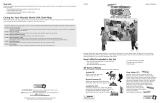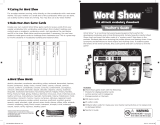Page is loading ...

Children often learn abstract concepts through visualization. What better
way to teach graphing, ordering, and categorizing than with the Rainbow
Pocket Chart! The chart has been divided into five sections for ease of
learning: Red, Yellow, Green, Blue, Purple. Each colored section of the
chart includes two pockets to fill with cards or pictures that help
represent classification, sorting, and graphing.
Rainbow
Pocket Chart
Great for graphing, sorting,
classifying, or organizing!
LER 2197

Using the Rainbow Pocket Chart
This guide contains hands-on activity ideas for use with the Rainbow
Pocket Chart. The chart’s five different sections provide a wonderful
opportunity to teach children about:
• Counting
• Reading
• Language mechanics
• Time
• Adding, Subtracting, Multiplying, and Dividing
• Science themes
• Social Studies topics, including timelines
Graphing
Help students build graphing skills with the Rainbow Pocket Chart.
Start by surveying students on their favorite kind of animal. Select five
different animals like a cat, dog, fish, hamster, and rabbit, and write
the name of each animal on a card or glue its picture to the card.
Then, place each card in a different colored segment of the chart.
Have children write their names on a card and place it in the section of
the pocket chart with their favorite animal. (For compatibility with the
pocket chart, Learning Resources recommends
using word card sizes of 2
1
⁄4" x 4" and picture
sizes of 2
3
⁄4" x 2
3
⁄4".)
Ask questions such as: "Which animal is the
most popular in the class?" and "Which animal
is the second most popular?" Explain to students that they have created
a bar graph as a class. For older students, extend this lesson into other
areas, such as math. For example, a survey of favorite animals can lead
to discussions of percentages and fractions.

Ordering
Teach a variety of ordering activities, from ordering
words to creating a sentence to ordering pictures of
clocks from the beginning of a day to the end of the
day. Also, use the chart to reinforce paragraph-writing
skills. Start by writing the following words on cards,
one word per card, and place them in order in the
red pocket:
"Ted was hungry for a turkey sandwich."
Then, write the following on cards, and mix up the
words in the appropriate pocket.
Yellow section:
First, he took out the turkey and bread.
Green:
Next, he toasted the bread.
Blue:
Then, he put turkey on the toast.
Purple:
Finally, his sandwich was ready.
Encourage children to move the words around to create a coherent
sentence and read the paragraph together as a class when completed.
Classifying
Help students classify objects with the Rainbow Pocket Chart. This is
especially useful in science. For example, you can teach the differences
among types of animals like birds, mammals, reptiles, amphibians,
and fish.
Start by writing animal types on cards, one type per card, and place
each card in its own segment of the Rainbow Pocket Chart. Ask
students, “What kind of skin outside do reptiles have?” “Do all reptiles
have this skin?” “Name some examples of reptiles.” Work through each
category in this manner and explain how animal types differ. Then,
encourage children to find pictures in magazines of the different kinds of
animals, cut them out, glue them to cards, and place them in the correct
category. Students can list the characteristics of each animal on the
backside of the card.
Extend this lesson into a social studies activity on the kind of climate
each type of animal lives in and why.
Organizing
The Rainbow Pocket Chart is also useful as an organization tool. The
pockets are durable to store manipulatives or hall passes. Also, use it
to display classroom announcements, inform students of upcoming
projects in each curriculum area, current events, field trips, and student
names for jobs and tasks.

For a dealer near you, call:
(847) 573-8400 (U.S. & Int’l)
(800) 222-3909 (U.S. & Canada)
+44 (0)1553 762276 (U.K. & Europe)
© Learning Resources, Inc., Vernon Hills, IL (U.S.A.)
Learning Resources Ltd., King’s Lynn, Norfolk (U.K.)
Please retain our address for future reference.
Made in China. LRM2197-GUD
Fabriqué en Chine. Informations à conserver.
Made in China. Bitte bewahren Sie unsere
Adresse für spätere
Nachfragen auf.
Hecho en China. Conservar estos datos.
/















